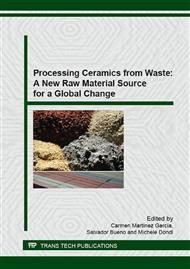p.50
p.62
p.75
p.86
p.94
p.105
p.115
p.127
p.133
Production of Ceramic Material Using Wastes from Brewing Industry
Abstract:
The industrial activities are responsible for the production of large amounts of solid wastes, which, so far, have found scarce reuse alternative. Clay-based materials show a natural forgiveness towards the incorporation of a wide variety of wastes. This study reported the changes in technological properties of clay-based mixture normally used in the production of bricks, due to the additions of a spent diatomite earth (SDE) discarded by the beer filtration process in the brewing industry. Samples containing 0-10 wt % SDE were extruded and sintered in air in an electric furnace (950 °C, for 3 h). SDE thanks to their organic substances content, during their combustion, act as pore forming agent and providing an energy support in the brick firing process. Also, the waste, because of its high silica content can act as a silica carrier. The results obtained showed that SDE, added in a percentage of 3 wt % to a brick formulation, had better influence with respect to control bricks containing only clay, improves the mechanical properties (compressive strength around 45 MPa) with a bulk density reduction of about of 2%. However, the incorporation of waste in percentage of 7 and 10 wt % had a negative effect due to increased porosity fundamentally open pores generated in the clay body by the combustion of SDE waste, leading to water suction, water absorption and compressive strength values that do not fall within the range specified by bricks UNE standards. Therefore, SDE can thus advantageously used in lower amounts (3 wt %) as silica carrier and in lower proportion as pore agent in clay bricks, with the potential to reduce fuel and natural ceramic raw material consumption, as well as, landfill costs.
Info:
Periodical:
Pages:
94-104
Citation:
Online since:
September 2015
Keywords:
Price:
Сopyright:
© 2016 Trans Tech Publications Ltd. All Rights Reserved
Share:
Citation:


